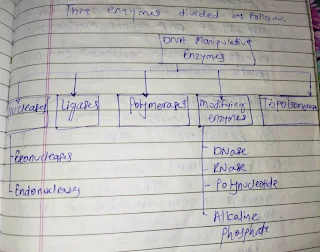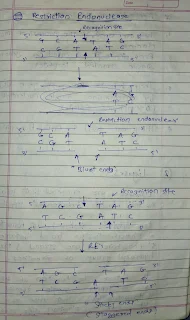Hello friends, In today's article, we see DNA Modification Enzymes used in Genetic Engineering. At this point, you get the whole enzyme information that helps in genetic engineering.
so let's start one by one
DNA Modification Enzymes Used in Genetic Engineering:-
DNA Modification Occurs during
1) Replication
2)Transcription
3) Genetic recombination
4) DNA repair
5) Epigenetic Regulations
DNA Manipulative Enzymes:-
So let's see one by one DNA modification Enzymes
I) Nucleases:-
- Nucleases enzymes cleave the phosphodiester bonds between monomers of Nucleic Acids.
- Nucleases enzymes is producing single and double-stranded breaks in target DNA Molecules.
- In Organisms, They are playing an essential role as machinery for many aspects of DNA Repair Mechanisms.
- Defects in Certain nucleases can cause genetic instability.
There are two types of Nucleases
1) Exonucleases:- These enzymes digest nucleic acids from the ends
2) Endonucleases:- These enzymes cut the regions in the middle of DNA target molecules.
1) Exonucleases:-
- Exonuclease is a nucleases enzyme that cleaves chemical bonds between nucleotides at the 3' or 5' ends of the nucleic acid chains.
- Exonucleases are important in DNA Repairing, Genetic recombination, Prevention of the occurrence of mutations genome stabilization.
- Bal 3I is isolated from a marine bacterium Alteromonus Espejiana. It is a Ca2+ dependent enzyme that degrades the nucleotides from both the strands of ds-DNA Molecules.
- In E.coli, there are 17 different exonucleases present including DNA Polymerase I, II, and III.
- Exonuclease III of E.coli digest one strand of the dsDNA molecule. it removes the nucleotide from the 3' terminus of the strand leaving 5' end overhands.
2) Endonucleases:-
- Endonucleases are enzymes that cleave the Phosphodiaster bond within a polynucleotide chain by recognizing specific sequences.
- Most of them are dimeric enzymes composed of two protein subunits.
- Two protein subunits wrap the double-stranded DNA and separately cleave both strands from both sides.
- SI Nuclease is an endonuclease isolated from Aspergillus Oryzae.
- It is a heat-stable enzyme, and it cleaves only single-stranded DNA.
- Another type of Endonuclease called DNase I is a non-specific enzyme. It is able to cleave both single and double-stranded DNAs by cleaving any of the internal Phosphodiater bonds.
-Another class of Endonucleases, is the Restriction Endonucleases cleaves DNA at specific sites having specific Polindromic Sequences.
SI Nuclease:-
DNase I:-
Application of Nucleases:-
1) They are used in the process of Molecular Cloning
2) Exonuclease III is used for Generating Single-Stranded Templates
3) They help to distinguish gene alleles by recognizing single Nucleotide polymorphisms.
4) They are used in DNA Fingerprinting.
2) Ligases:-
- Ligases are enzymes that join the nucleic acid molecules together.
- DNA Ligase catalyzes the formation of a phosphodiester bond between the 5' phosphate of one strand and the 3' hydroxyl group of another.
- In nature,
the function of DNA ligase is to repair single breaks (discontinuous) that arise as a result of DNA Replication or Recombination.
the function of DNA ligase is to repair single breaks (discontinuous) that arise as a result of DNA Replication or Recombination.
Role of DNA ligase in Genetic Engineering ( to join two DNA molecules)
- Results in Release of PPI
- The 5' phosphate group of the nick Attacks the phosphate of the adenylated ligase & itself gets activated,
- The 3' OH group of the nick now attacks the activated 5' phosphate group to release the AMP.
- The Nick gets ligated.
Applications of ligases:-
- DNA ligases are used with restriction enzymes to insert DNA fragments, often genes, into plasmids.
- Helps to perform blunt end as well as sticky end ligation.
- DNA ligase-I is used in-silico drug design to identify ligase inhibitors as possible therapeutic agents to treat cancer.
- Some ligases are used as targets for the development of new antibacterial drugs.
3) DNA Polymerase:-
- DNA Polymerase is an enzyme that catalyzes the synthesis of a new DNA strand from a pre-existing strand.
- The enzymes add deoxyribonucleotides to the free 3'-OH of the chain Undergoing Elongation. the Direction of Synthesis is 5'-3'.
- It has three major requirements for its activity:
a) A template strand
b) A primer with a free 3'-OH group
c) Four dNTPs
d) Some Cofactors like Mg2+ ions.
- Most Common DNA polymerase used in rDNA technology
a) DNA polymerase I of E.coli
b) Klenow Fragments
c) thermostable DNA Polymerase
d) Reverse Transcriptase
- E.coli DNA polymerase-I is an enzyme that has both DNA polymerase as well as DNA Nuclease activity.
- Different domains of E.coli Polymerase-I are responsible for different catalytic activities.
- The C-terminal is responsible for the polymerase activity.
- The N-terminal of the enzyme catalyzes the 5'- 3' exonucleases activity.
- The central region of the enzyme is responsible for 3'-5' exonuclease activity that can remove any misread nucleotide and hence acts as a proofreading mechanisms
- Polymerase-I is devoid of 5'-3' exonuclease activity ( which is unsuitable for many applications in RDT) is called a Klenow Fragment.
- Reverse Transcriptase (RT) is an RNA-dependent DNA polymerase found in RNA viruses also called retroviruses.
- This Enzyme is involved in the replication of retroviruses, where the RNA genome is first converted into DNA and then integrated into the Host.
- Reverse Transcriptase uses mRNA template instead of DNA For synthesizing new DNA strand (cDNA)
- Reverse Transcriptase also shows RNAse H activity that degrades the RNA molecule from a DNA-RNA hybrid.
- DNA Polymerase i.e. Thermostable DNA polymerase are a class of DNA polymerase that remains functional even at high temperature i.e. they are resistant to denaturation by heat treatment.
- They are isolated from the bacterium Thermus aquaticus that lives in Hot Springs.
- The enzyme isolated from this bacterium is known as ' Tag Polymerases.'
- Pfu DNA Polymerase is a thermostable enzyme isolated from micrococcus furiosus.
- In addition to 5' to 3' DNA polymerase activity, it also possesses 3' to 5' exonuclease ( ProofReading) activity.
- Pfu DNA polymerase exhibits the lowest error rate and is useful for polymerization reactions requiring high fidelity synthesis.
Application of DNA Polymerase:-
1) Tag Polymerase is used in the polymerization chain reactions ( PCR) technique which is used to amplify DNA Fragments.
2) Formation of a double-stranded DNA from the mRNA molecule using Reverse Transcriptase finds applications in Genetic engineering.
3) Klenow fragment is predominantly used in DNA Sequencing
4) Alkaline Phosphatases:-
- Alkaline phosphatase is purified from either E.coli or higher organisms e.g. Calf intestine.
- It is used for the removal of 5'-phosphate groups from nucleic acids in order to prevent recircularization of DNA vectors in cloning experiments.
- Now this vector can be joined with the foreign DNA and the nicks formed can be ligated using ligase.
- this Vector containing the insert is suitable for transformation.
Application of Alkaline Phosphatases:-
1) Removing 5' phosphate from plasmid and bacteriophage vectors that have been cut with a restriction enzyme.
2) Removing 5' phosphates from fragments of DNA before labeling with radioactive phosphate.
5) Polynucleotide Kinase:-
- It is a product of the T4 bacteriophage and commercial preparations are usually products of the cloned phage gene expressed in E.coli.
- The enzymatic activity of PNK is utilized in two types of reactions.
- PNK transfers the Gamma Phosphate from ATP to the 5' end of Polynucleotide ( DNA or RNA). The target nucleotide is lacking a 5' phosphate either because it has been dephosphorylated or has been synthesized chemically.
- In the ' Exchange reaction', target DNA or RNA that has a 5' phosphate is incubated with an excess of ADP. PNK will first transfer a phosphate from ATP onto the target Nucleic acid.
6) Ribonuclease (RNase):-
- Ribonuclease ( commonly abbreviated RNase is a type of nuclease that catalyzes the degradation of RNA into smaller components, by cleaving the phosphodiester bond between adjacent ribonucleaotide.
- RNase A which is obtained from bovine Pancrease cleaves next to Uracil and cytosine.
- RNase T1 derived from Aspergillus oryzae cleaves next to guanosine.
- Ribonuclease H ( RNase H) specifically degrades RNA in RNA/DNA hybrids.
Applications of Ribonuclease:- some of the major use of RNase A is
1)Eliminating or reducing RNA Contamination in preparations of Plasmid DNA
2) mapping mutations in DNA or RNA by mismatch Cleavage.
3) RNase will cleave the RNA in RNA::DNA hybrids at sites of single base mismatches and the cleavage products can be analyzed.
4) Useful in RNA Sequencing.
7) Topoisomerases:-
- During DNA replications and transcription, DNA becomes overwound ahead of a replication fork.
- If left unattended, this torsion would eventually stop the ability of DNA or RNA polymerase involved in these processes to continue down the DNA strand.
- Topoisomerases are enzymes that participate in the overwinding or underwinding of DNA.
- Topoisomerases bind to double-stranded DNA and cut the Phosphate backbone or either one or both the DNA strands.
- This intermediate break allows the DNA to be untangled or unwound and at the end of the DNA, the backbone is resealed again.
(... see in the image)
- Topoisomerases Divided into three types:-
1) Type I A:-
- This topoisomerase is present in all cells
- They rerxed only -ve supercoiled DNA
- in E.coli cells
a) Topoisomerase I
b) Topoisomerase III
- In Eubacteria and Archaea cells
a) Reverse gyrase
2) Type IB:-
- this topoisomerase present In eukaryotes and many prokaryotes
- they Relax both -ve and +ve supercoils.
- In humans present only
a) Topoisomerase I
3) Type I C:-
- This topoisomerase present in Archaea
- they relax +ve and -ve supercoils with a rate similar to or higher than other topoisomerases.
- In Archaea present only
a) Topoisomerase V
- A type II Topoisomerase cuts both strands of one DNA double helix, passes another unbroken DNA helix through it, and then relegates the cut strands.
- Type-II topoisomerases utilize ATP hydrolysis and are subdivided into two subclasses that possess similar structures and mechanisms.
A) Type IIA:-
-Present in Bacteria
a) DNA gyrase
b) Topoisomerase IV
- In Eukaryotes present only
a) Topoisomerase II
B) Type IIB:-
- Only one member that occurs in Archaea
- Topoisomerase VI
#The mode of Action of Type I and type II DNA Topoisomerase
A) A type I topoisomerase makes a
nick in one strand of a DNA molecule passes the intact strand through the nick and reseals the Gap.
B) A type II topoisomerase makes a double-stranded break in the double helix creating a gate through which a second segment of the helix is passed.
(...see in the image)
So this is all about the DNA modification enzymes used in genetic engineering.
Read More:-
Job Interview guide
buy from the following link
Click:- Buy it














Comments
Post a Comment
problem related comment